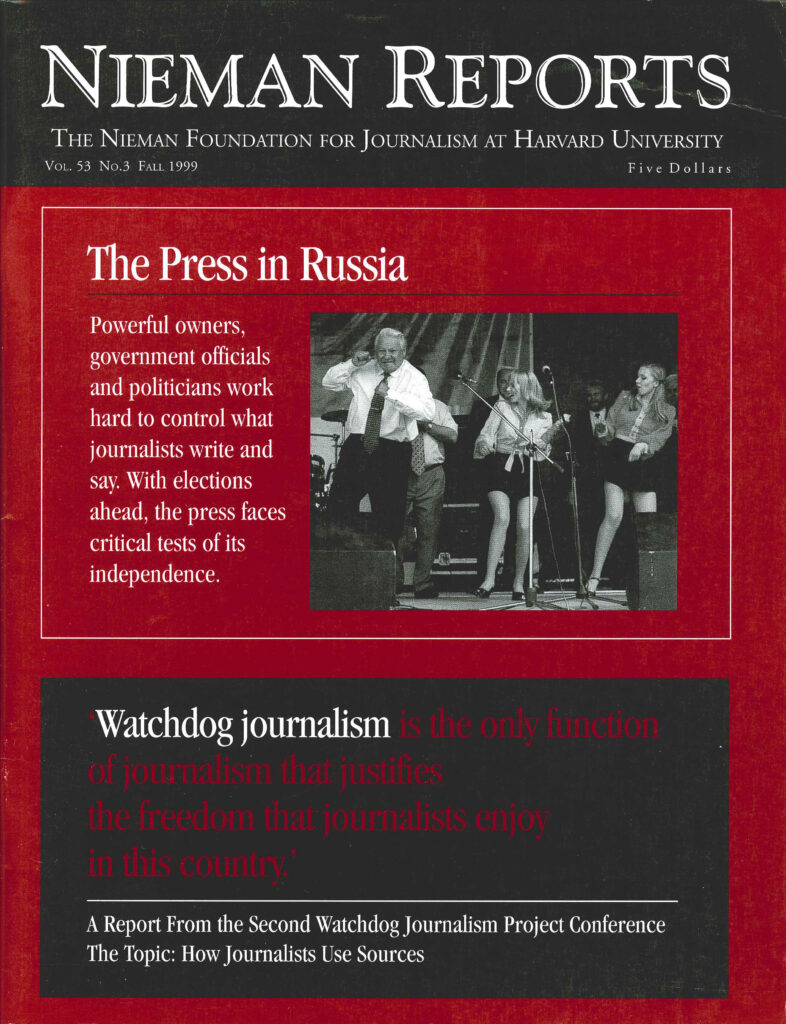“Today it is difficult to pick up a sports section or watch a sporting event on TV without finding some athlete’s privacy being invaded.” This observation rests at the center of Tom Witosky’s article that takes a close look at ways in which sportswriters make decisions about what aspects of an athlete’s life merit publication. Witosky, sports projects reporter for The Des Moines Register, sets forth questions that reporters should consider when probing into personal aspects of a sports figure’s life. Witosky’s article leads off a package of stories about sports reporting.
Michael Crowley, a reporter at The Boston Globe, complicates this issue of how journalists mesh what athletes do in their sport with what they do in their personal lives. Crowley dissects coverage of basketball great Michael Jordan and discovers that being a “sports hero” acts as a shield, protecting him against reporting that might show unflattering aspects of life off the court.
In an introductory essay David Halberstam wrote for “The Best American Sports Writing of the Century,” he reacquaints us with Gay Talese’s extraordinary portrait of Joe DiMaggio, who was the most celebrated athlete of his time but also a private man about whom little was known. He describes how Talese approached his task of reporting about this “icon of icons.”
Stan Grossfeld, a photographer at The Boston Globe, shares photos of a different sort of icon, Fenway Park, home of the Boston Red Sox. And Claire Smith, a sports columnist for The Philadelphia Inquirer, updates the situation for women sports reporters and finds that issues such as locker room access have been replaced by concerns about balancing work and family.
Melissa Ludtke, a former Time correspondent, meshes personal and professional perspectives to raise questions about “news” coverage of John F. Kennedy, Jr.’s plane crash.
Bernice Buresh, a former Newsweek correspondent, points to the continuing absence of nurses’ voices, experiences and research in the coverage of health care, and describes the consequences of such inattention by journalists. Jean Chaisson, a nurse, raises some of the vital questions which reporters should be asking nurses about patient care.
Edward M. Fouhy, a former top TV executive and now Editor of stateline.org, tells us what it’s been like for a long-time journalist to hook up with a much younger generation of “techies” to create a useful Web site for journalists covering state issues.
Kevin Noblet, Deputy International Editor at the Associated Press, reminds us that in this era of “new media,” not a lot has changed in the way news agency reporters do their jobs. The technology might be changing, but how the job gets done isn’t so different from years ago.
Michael Crowley, a reporter at The Boston Globe, complicates this issue of how journalists mesh what athletes do in their sport with what they do in their personal lives. Crowley dissects coverage of basketball great Michael Jordan and discovers that being a “sports hero” acts as a shield, protecting him against reporting that might show unflattering aspects of life off the court.
In an introductory essay David Halberstam wrote for “The Best American Sports Writing of the Century,” he reacquaints us with Gay Talese’s extraordinary portrait of Joe DiMaggio, who was the most celebrated athlete of his time but also a private man about whom little was known. He describes how Talese approached his task of reporting about this “icon of icons.”
Stan Grossfeld, a photographer at The Boston Globe, shares photos of a different sort of icon, Fenway Park, home of the Boston Red Sox. And Claire Smith, a sports columnist for The Philadelphia Inquirer, updates the situation for women sports reporters and finds that issues such as locker room access have been replaced by concerns about balancing work and family.
Melissa Ludtke, a former Time correspondent, meshes personal and professional perspectives to raise questions about “news” coverage of John F. Kennedy, Jr.’s plane crash.
Bernice Buresh, a former Newsweek correspondent, points to the continuing absence of nurses’ voices, experiences and research in the coverage of health care, and describes the consequences of such inattention by journalists. Jean Chaisson, a nurse, raises some of the vital questions which reporters should be asking nurses about patient care.
Edward M. Fouhy, a former top TV executive and now Editor of stateline.org, tells us what it’s been like for a long-time journalist to hook up with a much younger generation of “techies” to create a useful Web site for journalists covering state issues.
Kevin Noblet, Deputy International Editor at the Associated Press, reminds us that in this era of “new media,” not a lot has changed in the way news agency reporters do their jobs. The technology might be changing, but how the job gets done isn’t so different from years ago.



